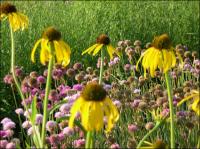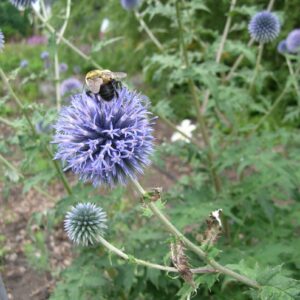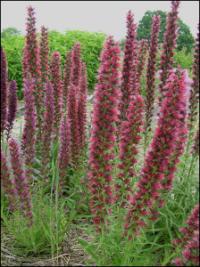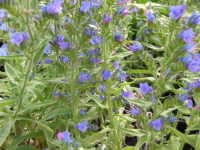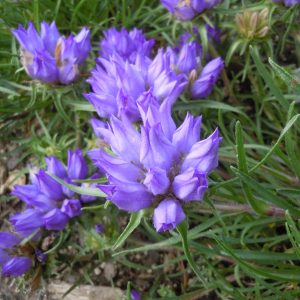Shop
Showing 273–280 of 788 results
-
Echinacea pallida Pale purple coneflower Z 4-8
Narrow, weeping pink rays in early summer surround hedgehog-like cone.
Narrow, weeping pink rays in early summer surround hedgehog-like cone.
Size: 2' x 14"
Care: Full sun in well-drained soil.
Native: much of continental US east of Colorado
Wildlife Value: attracts bees including bumblebees and caterpillars of some Skippers and a few moths. In fall finches eat the seeds. Deer resistant
Awards: Great Plants for Great PlainsEchinacea is Greek meaning hedgehog referring to the bristly conehead. Used to cure many ailments – arthritis, rheumatism, burns, colds, boils, fever, sore mouths, throats & gums, toothaches, snakebites, headaches, stings and distemper in horses – by several tribes – Cheyenne, Crow, Dakota and Sioux. 1st collected by Englishman Thomas Nuttall (1786-1859) who searched much of No. America finding thousands of new plants.
-
Echinacea paradoxa Bush’s coneflower Z 3-9
Sulfur yellow petals droop down below the bristly, brown central cone- Blooms in early summer
Sulfur yellow petals droop down below the bristly, brown central cone- Blooms in early summer
Size: 2-4' x 14"
Care: sun to part shade in moist well-drained soil
Native: Ozark Mountains of Arkansas and Missouri
Wildlife Value: attracts bees and butterflies. In fall finches eat the seeds. Deer resistantEchinacea is Greek meaning hedgehog referring to the bristly conehead. Paradoxa because yellow petals on a Purple coneflower is a paradox. The first description of this is based on plants collected by B.F. Bush in Swan, Nichols Junction and Eagle Rock Missouri in 1878 and 1898 as well as one collected by German planthunter “Father of Texas Botany” Ferdinand Lindheimer in Texas in 1843. Transactions of the Academy of Science of St. Louis, Vol XII January to December, “Notes on Some Plants of the Southwestern United States” J.B.S. Norton 1902, p. 40.
-
Echinacea purpurea Purple coneflower Z 3-8
Iconic dark pink rays with orange-rust cones from mid-summer to fall
ARCHIVED
Note: This is a plant not currently for sale. This is an archive page preserved for informational use.
Iconic dark pink rays with orange-rust cones from mid-summer to fall
Size: 3’ x 18”
Care: sun in well-drained humusy soil
Native: GA west to TX, north to NC, west to OH, IL & IA
Wildlife Value: Attracts many species of butterflies and bees; food for some moth and butterfly caterpillars; In fall Gold finches eat the seeds. Deer resistant.American Natives used Purple coneflower as a remedy for more ailments than any other plant, e.g. smoke treatment to cure headaches and sexually transmitted diseases, applied topically to toothaches and mumps and juice used for burns. The Winnebagos used the plant in advance to protect against burns. Also used to cure distemper in horses. Echinos is Greek for edgehog referring to the spiny cone. Introduced into garden cultivation by British John Tradescant the Younger from colonial Virginia in 1640.
-
Echinops ritro Globe thistle Z 3-9
Mid to late summer, round, steel blue flower heads at 1st prickly then turning soft and fuzzy.
Mid to late summer, round, steel blue flower heads at 1st prickly then turning soft and fuzzy.
Size: 3-4' x 18"
Care: Sun in well-drained soil, drought tolerant
Native: Southern Europe
Wildlife Value: attracts American painted lady butterflies, deer resistantThe name Echinops is Greek meaning “like a hedgehog” describing the circular spiny thistles. Introduced to England by 1570. Popular Victorian flower. Cultivated by Washington at Mount Vernon.
-
Echium russicum Vipers bugloss Z 2-9
Striking spikes of wine red in early summer, deadhead to rebloom. Short lived.
ARCHIVED
Note: This is a plant not currently for sale. This is an archive page preserved for informational use.
Striking spikes of wine red in early summer, deadhead to rebloom. Short lived.
Size: 20" x 16"
Care: Sun in moist well-drained soil or well-drained soil. Deer resistant
Native: Russia & eastern EuropeBristly hairs on stems can cause skin irritation. Echium is Greek for Viper’s bugloss because a concoction of the root and wine supposedly cured snake bites or acc’d to Gardeners’ Dictionary 1768 “because the ripe seed of this plant resembles the head of a viper.”. Collected before 1791 by Johann Gmelin, German botanist, who spent 10 years in Russia searching for plants, nearly dying in the process.
-
Echium vulgare Vipers bugloss Self-sowing biennial Z 3-8
Spikes of true blue blossoms touched with a hint of pink, May through September
ARCHIVED
Note: This is a plant not currently for sale. This is an archive page preserved for informational use.
Spikes of true blue blossoms touched with a hint of pink, May through September. Self-seeds readily, considered noxious weed in Washington. Bristly hairs on stems can cause skin irritation
Can not ship to: Idaho, Maryland and Montana
Size: 2-3’ x 12”
Care: sun in most any soil
Native: Europe.
Wildlife Value: Important pollinator for bees.In past leaves boiled for a tea to remedy headaches and fevers. In mid-1700’s grew on chalky lands over most of England. Echium is Greek for Viper’s bugloss because a concoction of the root and wine supposedly cured snake bites or acc’d to Gardeners’ Dictionary 1768 “because the ripe seed of this plant resembles the head of a viper.”
-
Edraianthus pumelo Dwarf grassybells Z 5-8
June to July cushion of up-facing purple bells atop silvery leaves
ARCHIVED
Note: This is a plant not currently for sale. This is an archive page preserved for informational use.
June to July cushion of up-facing purple bells atop silvery leaves
Size: 1” x 3”
Care: sun in very well-drained soil
Native: Balkins
Awards: Royal Horticultural Society Award of MeritDescribed in 1819 and named as a Campanula. Name changed in 1839.
-
Edraianthus tenuifolius syn. Wahlenbergia tenuifolius Grassy bells Z 5-8
Clusters of upfacing blue-purple bells in June, with a base of grassy foliage.
ARCHIVED
Note: This is a plant not currently for sale. This is an archive page preserved for informational use.
Clusters of upfacing blue-purple bells in June, with a base of grassy foliage.
Size: 4” x 8”
Care: sun to part shade in well-drained soil
Native: Dalmatia in southern Austria (Balkans)Introduced to gardens by M. Fröbel of Zurich who sent it to Kew Botanical Garden where it flowered in 1819. The name Edraianthus comes from Greek meaning “without a stalk.” Tenuifolius means “slender leaved.”


